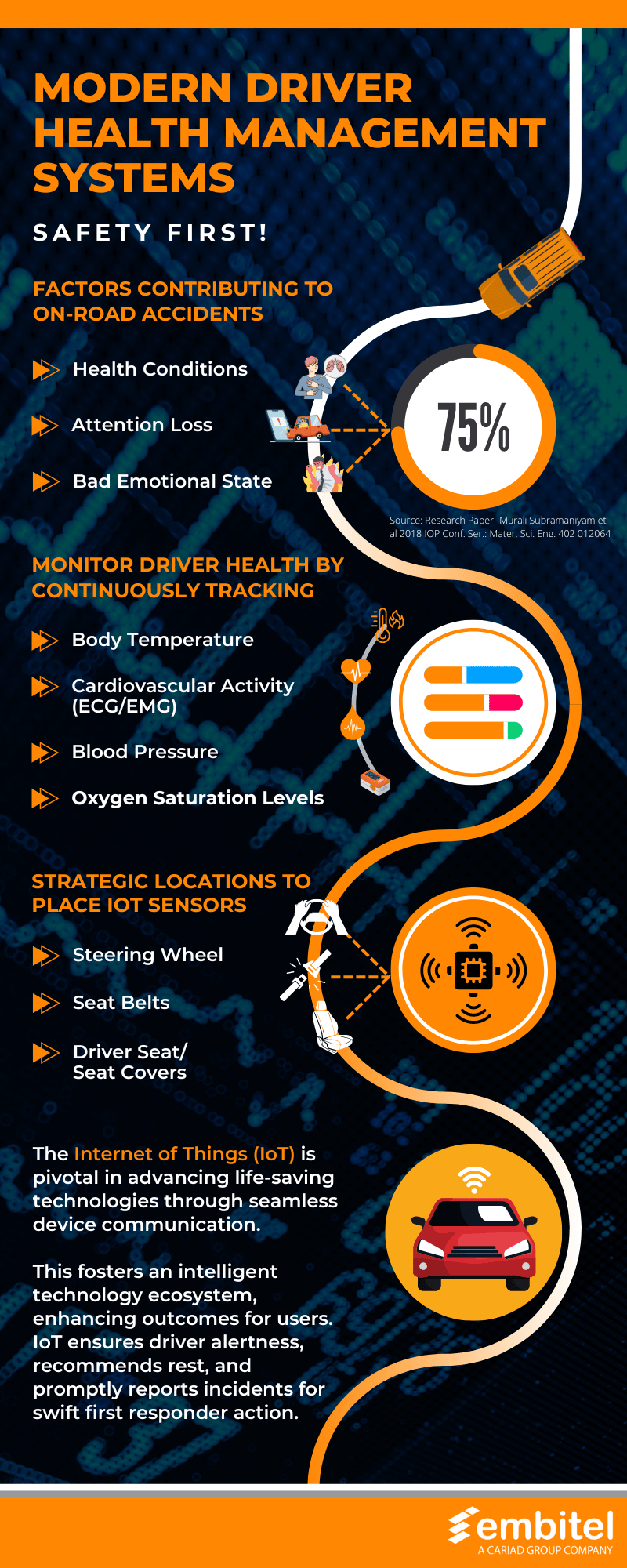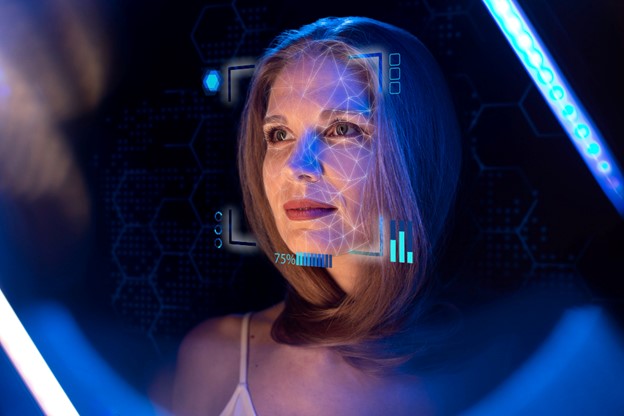IoT-Driven Driver Health Management Systems – Towards a Safer Driving Experience
Category : Embedded Blog
A driver’s role extends beyond steering and acceleration. Picture the open road, the engine’s hum harmonizing with passing scenery; yet this tranquility belies an ever-present threat: unprecedented driver health issues that could potentially have disastrous implications road safety.
As we accelerate towards a future of heightened transportation demands, the dangers of driver fatigue and health-related impairments loom large. A momentary lapse in focus could cascade into catastrophe.
To address this, envision a new era where vehicles function as vigilant guardians. Driver health management systems detect early signs of fatigue, stress, and underlying health conditions via body vitals, intervening to ensure alertness, well-being, and prompt actions.
The Foundation: IoT in Monitoring Driver Health
In our tech-infused transportation landscape, the imperative for such systems is clear. Understanding the dangers hiding beneath the surface propels us towards cutting-edge solutions. It’s not just about safeguarding vehicles; it’s about protecting lives.
The function of IoT enhances the connectivity capabilities of any modern vehicular technology solution. IoT sensor nodes play a crucial role as they collect data related to body vitals. Through this blog, let’s take a look at how using IoT as a foundation, researchers are trying to develop life-saving on-road technologies in the form of driver health management systems.
Vital Signs in Driver Health Monitoring
The critical parameters tracked in these driver health monitoring systems are vital body signs such as heart rate (HR), respiration rate (RR), electrocardiogram (ECG), electromyography (EMG), and galvanic skin response (GSR).
How do these vital signs play a role in defining a driver’s health? Let’s find out.
| Vital Signs | What do they measure? |
| Heart Rate (HR) | The focus of heart rate monitoring is to assess the general rhythm and rate of the heart. It is a broad measure of cardiovascular activity and can be indicative of overall physical exertion, stress, or relaxation. |
| Electrocardiogram (ECG) | ECG provides a graphical representation (electrocardiogram) of the heart’s electrical activity over time. It can identify specific patterns, irregularities, and abnormalities in the heart’s rhythm. These abnormalities may indicate such as cardiac conditions such as arrhythmias and atrial fibrillation. |
| Respiratory Rate (RR) | The focus of respiratory rate (RR) monitoring is to evaluate the frequency and rhythm of breathing. It is a general measure of respiratory activity, providing insights into changes in breathing patterns related to physical activity, stress, illness, or overall well-being. |
| Galvanic Skin Response (GSR) | This measures the change in electrical activity caused on the skin due to the amount of secretion produced by the eccrine sweat gland. GSR is known to detect changes in emotions. The eccrine gland responds to emotions such as sadness, fear, and joy differently. Hence, tracking these parameters will benefit in monitoring driver emotions. |
Note: Heart rate monitoring is a broader measure of the heart’s beats per minute, offering a general overview of cardiovascular activity. On the other hand, ECG is a more advanced diagnostic tool that provides detailed information about the heart’s electrical activity and can detect specific cardiac abnormalities.
Non-Invasive Driver Stress or Fatigue Management Systems
Driving around the city, where every scenario is unpredictable, can take any person’s mental peace out for a spin. The constant stress the drivers of modern automobiles face cannot be understated. IoT sensors have replaced electrodes to introduce non-invasive ways to track and manage driver health. These sensors are strategically placed on steering wheels, seats, and seatbelts. On-the-go analysis of the incoming vital health data in these systems is made possible due to IoT cloud & analytics capabilities.

Considering ECG, EMG, and GSR as Health Parameters.
Here, we analyse the study presented in a recent research report. To continuously track the stress levels of drivers, a team of researchers designed an AI-based Driver Assistance System (AI-DAS).
The main contributions of the proposed system for stress detection in car drivers utilize physiological signals such as ECG, EMG, GSR, and respiration rate to identify mental stress in automotive drivers. The system integrates a three-phase stress detection technique (SDT) consisting of bio signal pre-processing, feature extraction, and classification.
It employs the machine learning model Random Forest (RF), to accurately differentiate between stressed and relaxation states. The RF model is well known to classify and regress problems while considering the outputs of multiple decision trees.
Here, the multiple decision trees are the combinations of different scenarios and health parameters the drivers are exposed to.
The system achieves exceptional accuracy and sensitivity. The ability to process signals quickly and reliably showcases it as a reliable driver health management system. Algorithms such as RF model is one of the many AI/ML algorithms that can be used in developing systems with this functionality.
Considering Heart Rate (HR) and Respiration Rate (RR)
Heart and Respiration In-Car Embedded Non-Intrusive Sensors i.e., the HARKEN system is a comprehensive setup involving a seat sensor, a seat belt sensor, and a Signal Processing Unit (SPU). The functioning of this system is explained in this research paper.
The SPU plays a crucial role in processing real-time sensor data collected from seatbelt and seat cover, which includes capturing physiological signals to monitor fatigue-related physiological activity and prevent car accidents.
This monitoring extends to both mechanical and physiological activity associated with respiration and the cardiac cycle.
One of the innovative aspects of the system involves the integration of smart textile materials into the seat cover and safety belt. This integration allows the system to detect and filter out noise and artifacts caused by the vehicle’s motion.
Additionally, it calculates various parameters such as heart rate variability and respiration signals, presenting this information in a format that can be seamlessly integrated into a fatigue detector.
Moreover, the system overcomes certain limitations of conventional systems by utilizing smart textile materials and addressing issues related to the placement and pressure of safety belt straps for physiological monitoring. This innovative approach aims to enhance the accuracy and reliability of monitoring physiological signals in the context of driving, ultimately contributing to a safer driving experience.
Conclusion
There are several driver health management-related systems in the works that function by predicting and managing health conditions such as stroke.
The Internet of Things (IoT) plays a crucial role in developing life-saving technologies by enabling seamless communication between devices. This creates an intelligent technology ecosystem that thrives on interconnectedness, ultimately leading to better outcomes for those who rely on these technologies.
This ability will keep drivers alert, suggest rest when needed, and quickly report incidents as and when they occur, enabling quick response from first responders.




















